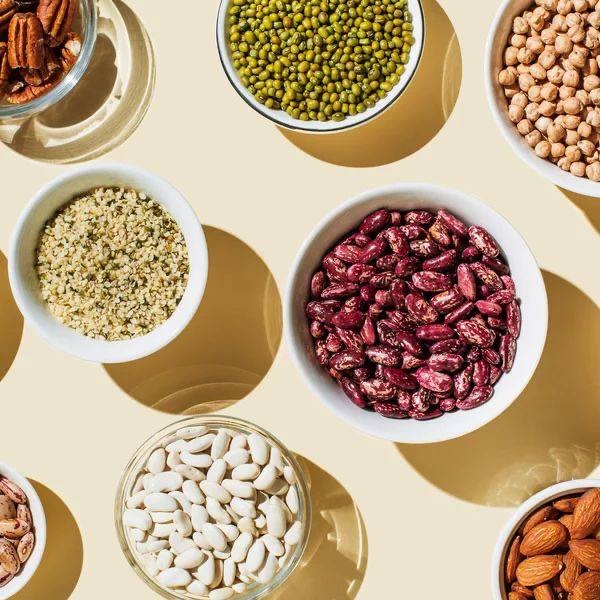Foods high in protein, fiber, and healthy fats can trigger the release of GLP-1, an important hormone that helps regulate blood sugar levels and promotes a feeling of fullness. Glucagon-like peptide-1 (GLP-1) plays a key role in blood sugar regulation.
It does this by stimulating the release of insulin and reducing the release of glucagon, a hormone that raises blood sugar. It also helps slow down digestion. This promotes a feeling of fullness and may help with weight management.
High-fiber foods like whole grains and vegetables, along with foods rich in proteins and healthy fats, can trigger the release of GLP-1. Eating certain foods can increase your body’s production of GLP-1. These foods are good for you and can improve other health measures, such as lowering your heart disease and cancer risk.
Foods that increase GLP-1 levels
Eggs
According to a 2016 research review, eggs are a rich source of protein and monounsaturated fats, which can play a role in GLP-1 secretion. Additional research from 2020 has identified egg whites as particularly beneficial for GLP-1 secretion (release).
ALSO READ: These Everyday Foods and Drinks Naturally Boost Your Energy
A study in the 2016 review compared a bagel breakfast with a meal that contains three eggs. The meal containing eggs was associated with lower post-meal blood glucose levels, reduced feelings of hunger, and decreased food intake over the next 24 hours.
According to the 2016 review, men also reported higher satisfaction after eating eggs. This indicates that eggs may help manage appetite and improve overall satisfaction with a meal.
Avocado
According to the 2016 review, avocados may increase GLP-1 levels through their high content of fiber and monounsaturated fats. The fiber in avocados can slow down digestion, leading to a more gradual release of glucose into the bloodstream.

One study from 2019 found that, compared with consuming a control meal, eating a whole avocado with a meal increased levels of GLP-1 along with another appetite-regulating hormone called peptide YY. It also reduces insulin levels.
Vegetables
Vegetables such as Brussels sprouts, broccoli, and carrots are high in fiber and vitamins, which can help regulate blood sugar levels and potentially affect GLP-1 levels. A study conducted in Jakarta, Indonesia, found that consuming vegetables before carbohydrates significantly affected glucose and GLP-1 levels in individuals with type 2 diabetes, especially 60 minutes after eating.
High Fiber Grains
The same 2016 research review suggests that high-fiber grains like oats, barley, and whole wheat may increase GLP-1 in several ways. However, their results show that soluble fiber slows digestion. This leads to a gradual release of glucose into the bloodstream, which triggers the release of GLP-1.
Also, when gut bacteria ferment fiber, it produces short-chain fatty acids (SCFAs) like acetate, propionate, and butyrate. The research examined in the 2016 review suggests that these SCFAs can stimulate Glucagon-like peptide-1 release by binding to L-cell receptors.
Healthy Fats
Healthy fats, such as those found in avocados, nuts, and olive oil, are rich in monounsaturated and polyunsaturated fats, which stimulate the release of GLP-1. They’re also crucial for brain health and hormone production.
Berries
Berries, such as blueberries and strawberries, are rich in antioxidants, which can help lower inflammation and improve overall health. They’re also low in sugar compared to other fruits.
Legumes
Legumes, including beans, lentils, and chickpeas, are high in fiber and protein, which can help regulate blood sugar levels and promote digestive health.
Leafy Greens
Leafy greens, such as spinach, kale, and Swiss chard, are rich in fiber, vitamins, and minerals, which can help regulate blood sugar levels and improve overall health.
ALSO READ: Biden Signs Executive Order Expanding Women’s Health Research
Nuts
The 2016 research review previously mentioned suggests that almonds, pistachios, and peanuts may increase GLP-1 levels through their protein, fiber, and healthy fat content.

In addition, the fiber in these nuts slows digestion, leading to a gradual release of glucose into the bloodstream and a corresponding increase in GLP-1 secretion. The healthy fats in nuts also play a role, as they can help improve insulin sensitivity.
Hence, consuming whole grains, nuts, eggs, and vegetables can help increase blood sugar regulation, which may aid in managing diabetes and promoting satiety.
You Might Also Like:
6 Popular Makeup Trends on Our Radar for 2024
Bruce Willis’ Wife Honors Him With a Heartfelt Post on His Birthday
Mastering Suit Styles for Every Occasion
Top 13 Deodorants Rated Best by Dermatologists and Sweat Warriors
